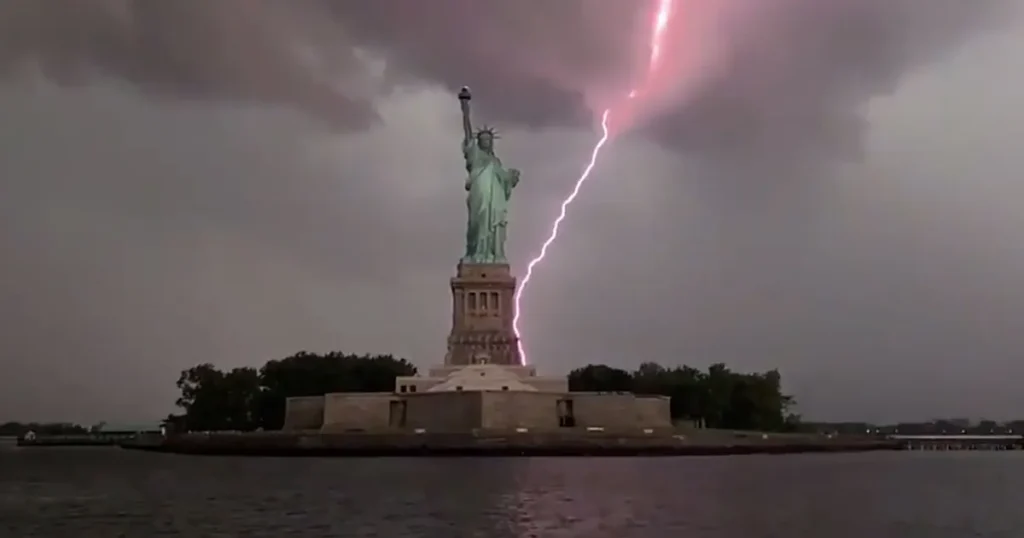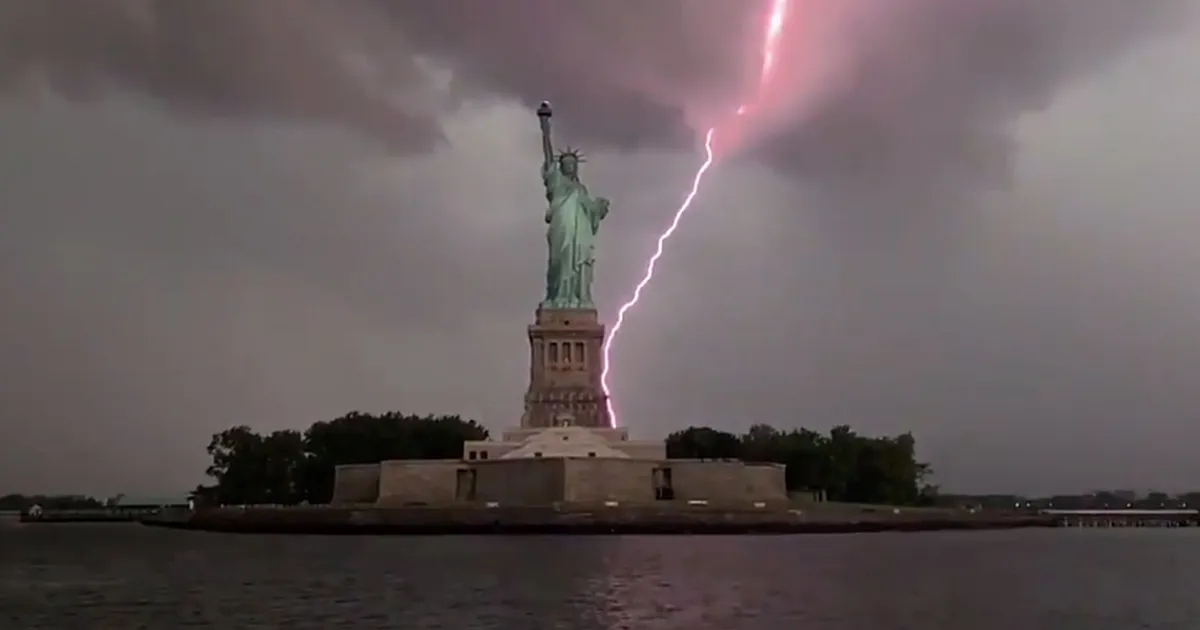
Table of Contents
Statue of Liberty Lightning, A Breathtaking Moment Amidst Turmoil
Statue of Liberty Lightning – New York City-based photographer, Dan Martland, captured an extraordinary moment as lightning struck the iconic Statue of Liberty on a stormy Wednesday afternoon. The electrifying bolt, seemingly emanating from Lady Liberty’s torch, created a stunning visual spectacle that left viewers awestruck. Martland promptly shared the striking images on his Instagram account, accompanied by the enthusiastic caption,
“She’s Electric! This afternoon’s passing storm didn’t disappoint. The #StatueOfLiberty getting zapped by a bolt of Lightning. My first strike of 2024.” This awe-inspiring event occurred merely days following a powerful earthquake that rattled the city, coupled with a fierce storm that unleashed strong winds and torrential rain.
Statue of Liberty Lightning –Martland, known for his keen eye and skillful photography, shed light on his approach to capturing such remarkable moments. He revealed, “I typically rely on weather apps to gauge conditions before venturing out for a shoot.” Despite experiencing prolonged waits in the past, Martland emphasized that on this occasion, the storm passed swiftly, granting him the opportunity to capture the breathtaking scene within just an hour.
Responding to inquiries regarding the authenticity of his images, Martland assured skeptics that his photographs are genuine, captured with the assistance of a lightning trigger to precisely document the lightning strikes.
This latest capture of the Statue of Liberty Lightning being struck by lightning adds to Martland’s impressive portfolio, underscoring the unpredictable and awe-inspiring forces of nature. In fact, a similar image from April 2023 can be found on Martland’s Instagram account, further highlighting the remarkable phenomena he has documented over the years.

However, Statue of Liberty Lightning amidst the awe-inspiring display of nature’s power, Wednesday’s storm also brought tragedy to the region. Falling trees claimed the life of Catherine Tusiani in Westchester County, serving as a stark reminder of the potential dangers associated with severe weather conditions. The impact of the storm was felt across the city, with numerous trees uprooted and causing damage to property and vehicles. In response, authorities issued flood warnings and urged residents to exercise caution.
As New York City grapples with the aftermath of these tumultuous events, Martland’s striking photographs serve as poignant reminders of both the beauty and ferocity of nature. They encapsulate the resilience of the city and its inhabitants in the face of adversity, while also highlighting the need for vigilance and preparedness in the midst of natural disasters.
What Causes Lightning ?
Zap! You’ve just touched a metal doorknob after sliding your rubber-soled shoes across the carpet. Yikes! Lightning seems to have struck you! Well, not exactly, but the scenario is quite similar.
The rubber soles of your shoes pick up stray electrons from the carpet, gathering a static charge. (Static, in this context, means stationary.) Static charges are always on the lookout for an opportunity to discharge. When you make contact with a metal doorknob—or any conductor of electricity—it presents that opportunity, and the surplus electrons eagerly take advantage of it.
But do thunderclouds really wear rubber shoes? Not quite, but there’s plenty of activity happening inside the cloud. Lightning originates from static charges within a rain cloud. Turbulent winds inside the cloud lift water droplets at the bottom to high altitudes, where the colder atmosphere freezes them. At the same time, downdrafts push ice and hail downwards. When these elements meet, electrons are stripped away.
This results in a cloud with a negatively charged bottom and a positively charged top. These electrical fields become incredibly strong, with the atmosphere acting as an insulator between them within the cloud. When the charge strength surpasses the insulating properties of the atmosphere, Z-Z-Z-ZAP! Lightning strikes.
But how does lightning decide where to strike? The electric field seeks the path of least resistance to discharge, often occurring between clouds or within a cloud. However, the lightning that concerns us the most is cloud-to-ground lightning—because that affects us!
As a storm moves across the ground, the negative charge in the cloud attracts positive charges in the ground. These positive charges move upwards into tall objects such as trees, telephone poles, and buildings. A “stepped leader” of negative charge descends from the cloud, seeking a path to the ground. As it nears, a positive charge, known as a streamer, reaches up to meet it. When they connect, we see the lightning bolt.

So, what causes thunder? In a fraction of a second, lightning heats the surrounding air to extremely high temperatures—as hot as 54,000 °F (30,000 °C). This rapid heating causes the air to expand explosively, creating a shockwave as the surrounding air is rapidly compressed. The subsequent rapid contraction generates an initial CRACK sound, followed by rumbling as the air column continues to vibrate.
If we’re observing the sky, we see the lightning flash before we hear the thunder because light travels faster than sound. We can estimate the distance of the lightning by counting the seconds until we hear the thunder—it takes approximately 5 seconds for sound to travel 1 mile. If thunder follows lightning almost immediately, it means the lightning is dangerously close!
How probable is it for lightning to strike a person? Around 400 people in the U.S. are struck by lightning annually, resulting in approximately 50 fatalities and numerous permanent disabilities. Lightning safety guidelines include seeking indoor shelter during storms and avoiding tall objects and open areas.
Lightning plays a crucial role in weather prediction. Instruments like the Geostationary Lightning Mapper detect lightning activity, assisting in the forecasting of severe weather events such as thunderstorms, tornadoes, and flash floods.

